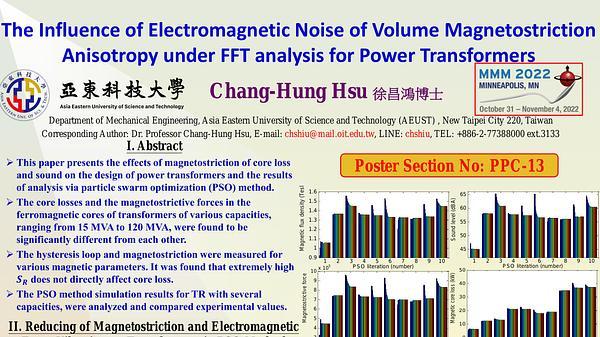Would you like to see your presentation here, made available to a global audience of researchers?
Add your own presentation or have us affordably record your next conference.
Variable flux memory machines (VFMM) using low coercive force (LCF) permanent magnets (PM) have been extensively investigated 1-5. Normally, the series hybrid
magnet topology equipped with both PM with high coercive force (HCF) and LCF PMs to achieve high torque density and extended constant power speed range simultaneously, and two
kinds of PMs are magnetically connected in series to avoid unintentional demagnetization in LCF magnets. Nevertheless, the role LCF PM acts in the series magnetic circuit and its
potential effect on the air-gap flux density remain unclear. In this paper, the flux barrier effect of LCF PM on series VFMM is revealed and investigated, and an approach to preventing the
air-gap flux density drop is presented.
The conventional series hybrid magnet VFMM and interior permanent magnet (IPM) machine sharing identical usage of HCF PMs are shown in Fig.1. In Fig.1(e), the back-EMF amplitude
of the series VFMM is lower than that of the IPM machine. This is mainly due to the fact that the air-gap flux enhancement by the magnetomotive force of the LCF PM cannot compete
with the weakening effect by the magnetic reluctance of LCF PM. As a result, the flux barrier effect of the LCF PMs is identified, which further leads to a reduction of the torque density.
The topology of VFMM with dual-layer PMs is shown in Fig.1(c). The separation of the PMs weakens the barrier effect on the HCF PM and the bypass flux path reduces the equivalent
reluctance in the magnetic circuit. It can be observed in Fig.1 (d) that the air-gap flux density and flux variable range are improved. That is to say, the magnetic flux barrier effect of LCF
PM is reduced with the proposed dual-layer PM design.
The test results of the open-circuit back-EMF of the dual-layer series hybrid magnet VFMM prototype are shown in Fig.2. The experiments agree well with the FE-predicted results. The
detailed analysis, suppression methods of the flux barrier effect, and the detailed test results, will be given in the full paper.
References:
1 V. Ostovic, "Memory motors," IEEE Ind. Appl. Mag., vol. 9, no. 1, pp. 52-61, Jan./Feb. 2003.
2 K. Sakai, K. Yuki, Y. Hashiba, N. Takahashi and K. Yasui, "Principle of the variable-magnetic-force memory motor," in Proc. Inter. Conf. Elec. Mach. System. (ICEMS), 2009, pp. 1-6.
3 N. Limsuwan, T. Kato, K. Akatsu and R. D. Lorenz, "Design and evaluation of a variable-flux flux-intensifying interior permanent-magnet machine," IEEE Trans. Ind. Appl., vol. 50,
no. 2, pp. 1015-1024, Mar./Apr. 2014.
4 H. Hua, Z. Q. Zhu, A. Pride, R. Deodhar and T. Sasaki, "A novel variable flux memory machine with series hybrid magnets," in Proc. 2016 IEEE Energy Conversion Congress and
Exposition (ECCE), 2016, pp. 1-8.
5 H. Yang, H. Zheng, H. Lin, Z. Q. Zhu and S. Lyu, "A novel variable flux dual-layer hybrid magnet memory machine with bypass airspace barriers," in Proc. 2019 IEEE International
Electric Machines & Drives Conference (IEMDC), 2019, pp. 2259-2264.

